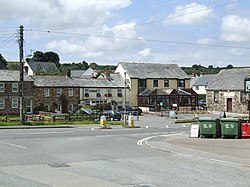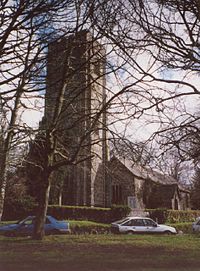Lanivet
| Lanivet | |
| Cornwall | |
|---|---|
 Lanivet village | |
| Location | |
| Grid reference: | SX039642 |
| Location: | 50°26’42"N, 4°45’47"W |
| Data | |
| Population: | 1,961 (2011) |
| Post town: | Bodmin |
| Postcode: | PL30 |
| Dialling code: | 01208 |
| Local Government | |
| Council: | Cornwall |
| Parliamentary constituency: |
North Cornwall |
Lanivet is a village in Cornwall about two and a half miles southwest of Bodmin. Before the Bodmin by-pass was built, the A30 trunk road between London and Land's End passed through the village.
The Saints' Way long-distance footpath passes Lanivet near its half-way point.
The parish includes the hamlets of Bodwanick, Bokiddick, Lamorick, St Ingunger, Trebell, Tregullon, Tremore, and Woodly. Part of St Lawrence is also in this parish. An electoral ward of the same name surrounds Bodmin. Its population at the 2011 census was 4,241.[1]
Parish church

The church tower is built in the Perpendicular style and in 1878 had six bells. Renovations to the porch, nave and aisles were completed in that year along with the extension of the burial ground by enclosing an adjacent field.[2] Within the church are monuments of the Courtenays of Tremere.[3]
In the churchyard are two ancient stone crosses and a rare example of a hogback grave dating from Viking times. Langdon (1896) also records the existence of four more stone crosses in the parish.[4][5]
About the village
About a quarter of a mile from the church are the remains of St Benet's, a monastery of the Benedictine order, said to have been subordinate to Monte Cassino, in Italy, or according to others, Clairvaux in Burgundy. It was founded as a lazar house in 1411 and during the 15th-century a chapel with a tower and an adjacent longhouse were built. The building work was not complete by 1430; it is mentioned in a document of 1535. The tower and longhouse are mentioned by Charles Henderson as being still in existence; he refutes the idea of it as an abbey.[6]
After the Reformation it became the home of the Courtenay family; the present house looks 19th-century with 15th-century windows built into the facade. [5] St Benet was restored by, its then owner, Charles Eldon Sargeant in 1878, and is described by The Cornishman newspaper as ″... a charming and picturesque place.[2]
St Ingunger, in the parish, is said to have been the residence of the hermit, Saint Congar of Congresbury, in the early 6th-century. Churches dedicated to him may also be found in Brittany and Cornwall.[7]
Industry
In the adjacent hills, tin and iron extraction ceased in (or just before) 1878, and all that was left of the industry was one or two tin-stamps.[2]
Thomas Hardy
Thomas Hardy came to Lanivet in August 1872 to visit the home of Emma Gifford where he was introduced to her parents at Kirland House. Hardy was to marry Emma in in the autumn of 1874. At the time of his visit in 1872, he wrote a poem in the same year entitled Near Lanivet.[8]
Outside links
| ("Wikimedia Commons" has material about Lanivet) |
References
- ↑ "Ward population 2011". http://www.ukcensusdata.com/lanivet-e05008236#sthash.SlWMiI2g.dpbs. Retrieved 6 February 2015.
- ↑ 2.0 2.1 2.2 "Lanivet". The Cornishman (20): p. 7. 28 November 1878.
- ↑ Nikolaus Pevsner: The Buildings of England: Cornwall, 1951; 1970 Penguin Books ISBN 978-0-300-09589-0page 91
- ↑ Langdon, Arthur G. (1896) Old Cornish Crosses. Truro: J. Pollard; pp. 295, 383, 412, 419
- ↑ 5.0 5.1 Nikolaus Pevsner: The Buildings of England: Cornwall, 1951; 1970 Penguin Books ISBN 978-0-300-09589-0
- ↑ Henderson, Charles: Cornish Church Guide (1925) Truro: Blackford; p. 129-30
- ↑ Gilbert Hunter Doble, (1970) The Saints of Cornwall: part 5. Truro: Dean and Chapter; pp. 3-29
- ↑ Millgate, Michael (1982) Thomas Hardy: a Biography Revisited, Oxford U.P. p. 131
